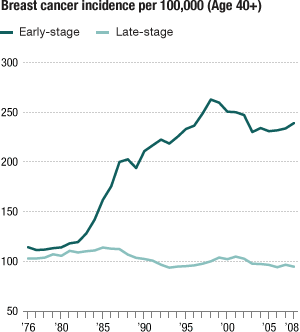The endless debate over routine mammograms is getting another kick from an analysis that sharply questions whether the test really does what it’s supposed to.
Dr. H. Gilbert Welch, coauthor of the analysis of mammography’s impact, which was just published in the New England Journal of Medicine, tell Shots that the aim was to “get down to a very basic question.”
That is, do annual mammograms among women over 40 discover early-stage breast cancers that can be treated so that they never become deadlier late-stage tumors?
Welch, of Dartmouth Medical School, and coauthor Dr. Archie Bleyer of the Oregon Health and Science University, analyzed 30 years of data on breast cancer incidence.
“And what we see is a dramatic increase — a doubling — in the amount of early-stage cancer,” Welch says. “But we don’t see a corresponding decrease in the amount of late-stage cancer.”
They say this means mammography isn’t catching many advanced breast cancers — even though it’s very good at catching early tumors.
Too good, perhaps. The duo says many of the early tumors revealed by mammography don’t need to be treated at all. Doctors call that “over-diagnosis.”
Welch says more than a million women have been over-diagnosed with breast cancer over the past 30 years. And the problem continues.
“Seventy thousand women a year are over-diagnosed and treated unnecessarily for breast cancer,” Welch says.
This all may come as a shock to many women — and their doctors. No other diagnostic test has been more aggressively promoted than mammography — or, lately, been so controversial, with the possible exception of PSA tests for prostate cancer.
“Whenever I see a paper like this, I say, ‘Oh, boy, here we go again!'” says Dr.Carol Lee, a breast imaging specialist at Memorial Sloan-Kettering Cancer Center in New York City.
Lee is on the communications committee of the American College of Radiology, whose members often do mammograms. The group, in a statement, says the new analysis “is simply wrong.”
The ACR statement’s main criticism is that Welch and Bleyer don’t account for what the radiologists say was a steady increase in the incidence of invasive breast cancer. They say that can explain why mammography didn’t lower the incidence of advanced breast cancer more.
Welch rejects that claim. “Why was breast cancer incidence so stable in the late ’70s, only to shoot up in the 1980s – the very time mammography was introduced?” he writes in an email. “Why didn’t incidence rise dramatically in women under 40 — those not exposed to screening?”
Welch is no newcomer to debates over the benefits and harms of diagnostic screening tests. In fact, he’s a well-known iconoclast, who last year published the popular book Overdiagnosed: Making People Sick in the Pursuit of Health.
“He has a preexisting bias, just as those of us in the breast imaging community have a preexisting bias,” Lee says. “The truth probably lies somewhere in between.”
Still, Lee finds it hard to believe that 70,000 women a year are diagnosed with breast cancer that would not have progressed. And she says the debate isn’t very helpful to most women.
“What my friends in Connecticut want to know is, ‘Should I have a screening mammogram?’ And … this kind of study sometimes raises more questions than it answers,” Lee says.
San Francisco breast surgeon Laura Esserman agrees that women are tortured by these endless debates. But she sees a way out of the dilemma.
“Our concept of cancer has got to change,” she tells Shots. “We now recognize that there isn’t just one pathway — it’s not cancer, yes or no.” And doctors know now that cancer doesn’t always lead to death.
Esserman thinks mammography screening should be done more selectively. Women at lower risk of breast cancer — because they don’t have close relatives who’ve had it or have a genetic predisposition for it — may not need to be screened so often.
Second, she says women and their doctors have to get out of the mind-set that any breast cancer should be treated maximally. For instance, doctors now routinely deploy surgery, hormones and radiation to treat a condition called ductal carcinoma in situ, or DCIS.
“We can watch a lot of those things and most of them turn out to be just fine,” she says.
But this is a long way from how either mammography or breast cancer treatment is practiced right now.







